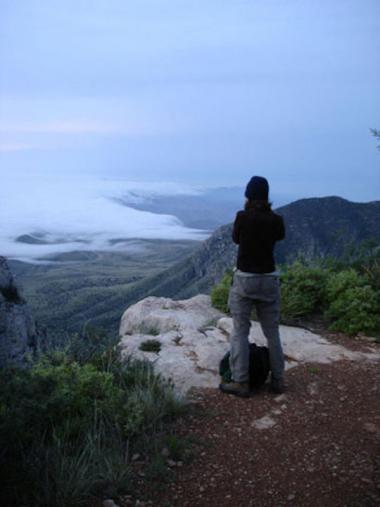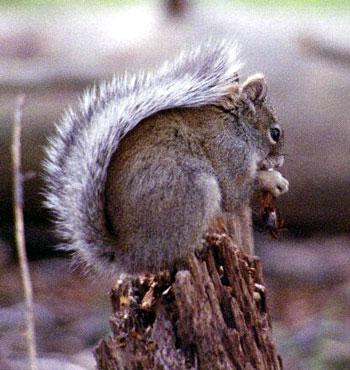Claire A. Zugmeyer
Past Graduate Student

-
ENR2
1064 E Lowell St
Tucson, AZ 85719
Response of endangered Mt. Graham red squirrels to severe insect infestation
Major Questions
Disturbance events create temporal and spatial heterogeneity of resources that can cause short- and long-term changes to habitat and disrupt interactions between individuals and resources. Severe disturbance may dramatically alter habitat structure, causing reduced reproductive success or site abandonment. Rates and impacts of natural disturbances are predicted to increase with current
trends in climate change, thus highlighting the need to understand species' response to disturbance. My research examined the response of the endangered Mt. Graham red squirrel to severe insect infestation. The Mt. Graham red squirrel (Tamiasciurus hudsonicus grahamensis) occupies high elevation spruce-fir and mixed-conifer forests of the Pinaleño Mountains in southeastern Arizona. Recent recolonization of insect-damaged forest provided an opportunity to examine response of red squirrels to insect infestation. I examined habitat selection, home range, body mass, and demography of Mt. Graham red squirrels inhabiting insect-damaged forest and drew comparisons to squirrels living in relatively undamaged forest.
Major Findings
I examined habitat selection within insect-damaged forests by comparing physical and vegetative characteristics at 1) occupied middens, 2) a random subset of unoccupied historical middens, and 3) random locations. Mt. Graham red squirrels established middens in areas with <64% tree mortality. Greater basal area, canopy cover, and log volume best distinguished middens from random locations. Only greater basal area of live trees significantly distinguished occupied middens from unoccupied middens. Midden surface temperature depended on surrounding vegetation structure and tended to be cooler at occupied middens than unoccupied middens. These habitat components are congruent with features found at middens prior to the insect infestation as well as those found in other parts of the red squirrel distribution, indicating that red squirrels do not alter habitat selection after insect disturbance. I used radiotelemetric techniques and live-trapping to examine home range, body mass, and demographics of Mt. Graham red squirrels inhabiting insect-damaged and healthy forest. Squirrels living within insect-damaged forest had larger home ranges than squirrels within healthy forest. Females had larger home ranges than males in healthy forest, but I detected no difference between sexes in insect-damaged forest. Squirrel body mass, reproductive condition, and litter size did not differ between forest types, suggesting insect-damaged forest provided adequate resources. However, squirrels inhabiting insect-damaged forest experienced lower survivorship and 50% fewer potential reproductive events than squirrels in healthy forest. Although Mt. Graham red squirrels demonstrate equal-preference for habitat within insect-damaged forests and reproduce as well as individuals in healthy forest, poor survivorship and reduced potential to reproduce suggest insect-damaged forest may function as an ecological trap and has potential to threaten the persistence of this isolated population. Therefore, preservation of remaining healthy forest is a priority for management of this endangered species.
Publications
Zugmeyer, C. A. and J. L. Koprowski. 2009. Severely insect-damaged forest: A temporary trap for red squirrels? Forest Ecology and Management 257: 464-470. PDF of Article
Zugmeyer, C. A. and J. L. Koprowski. 2009. Habitat selection is unaltered after severe insect infestation: Concerns for forest-dependent species. Journal of Mammalogy 90: 175-182. PDF of Article
Zugmeyer, C. A. and J. L. Koprowski. 2007. Avian nestling predation by endangered Mt. Graham red squirrel. The Southwestern Naturalist 52(1): 155-157. PDF of Article
Zugmeyer, C. A. 2007. Trailblazers in the forest: response of endangered Mt. Graham red squirrels to severe insect infestation. M.S. Thesis. University of Arizona, Tucson, AZ. 73 pp. PDF available through the U of A library, or contact John L. Koprowski for more information.
Where is Claire Now?
Ecologist
The Sonoran Institute
100 N. Stone Suite 400
Tucson, AZ 85701
https://sonoraninstitute.org/our-story/people/



